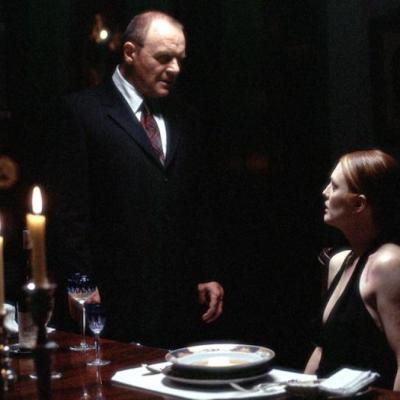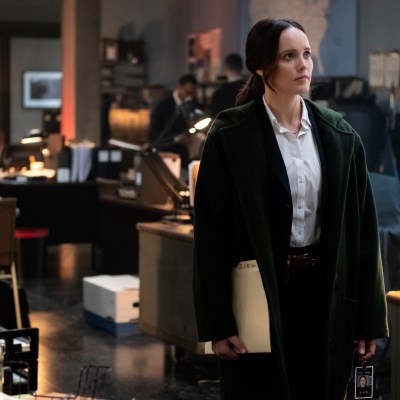Special agent Clarice Starling is breathing heavily as she forces herself to turn the next tight corner. Between deep breaths, she knows somewhere in the back of her mind that she’s being watched. And she can assume those invisible, cold male eyes are making a judgement of her five-foot and three-inch frame: She’s in over her head. Yet she pushes past any condescending skepticism, and she perseveres through the proverbial dark.
At a glance, this could apply to the climax of The Silence of the Lambs, Jonathan Demme’s masterful psychological thriller which finishes with a cat and mouse game of Starling (a peerless Jodie Foster) crawling through the dungeon created by Ted Levine’s Buffalo Bill. In that blackness, serial killer Bill most certainly watches her, playfully (mis)judging her aptitude for handling his house of horrors. Yet all of these elements are also evident in Silence of the Lambs’ very first scene.
On a sleepy late wintry morning in Virginia, we’re introduced to Starling already overcoming another manmade trap meant to exclude her. At the FBI’s Quantico obstacle course, we witness the quiet and earnest determination which defines Clarice as she ascends up a rope line and when she flips over a cargo net. She’s acutely aware that the deck is probably being stacked against her behind her back, but she remains unfatigued and undaunted. She doesn’t even wince when the FBI instructor who emerges from the shadows to summon her down to the office mispronounces her name: He calls her “Sterling.”
It’s only a few minutes at the top of Silence of the Lambs, but it’s shot with Demme’s signature attentiveness and subtlety. While the director never draws direct attention to his filmmaking and blocking techniques, his visual language is pristine and unmistakable.
From the jump, Clarice is in a maze, a labyrinth of manmade systems and challenges that appear to reject her very presence. And she never once steps away from their course. They’re with her at the finale in Buffalo Bill’s portal to hell, but they also manifest in the bureaucratic cages and then literal holding pens Dr. Frederick Chilton (Anthony Heard) ushers Clarice through as a power move—a brusque display of authority and arrogance after Clarice rebuffed Chilton’s sleazy pick-up line a moment earlier in the film. “See what an important man you missed the chance of getting to know?” he projects through a curdled sneer.
Chilton is, of course, taking Clarice to meet the man he calls “the Monster:” Dr. Hannibal Lecter (a mighty Anthony Hopkins who demonstrates the eviscerating power of stillness). And one doubts Dr. Lecter would disagree with that title. It’s easy to imagine the disgraced cannibal psychiatrist musing that if Clarice’s life is a series of mazes and evaded dead ends, then her lifetime amounts to a single, titanic struggle against a minotaur—the ultimate monster of Greek mythology who devoured young men and women fed into his maze.
Yet in Silence of the Lambs, the all-consuming Dr. Lecter is hardly the only monster in Clarice’s life, even if he is the creature at the center of Chilton’s labyrinth. Rather the real Monster (with a capital “M”) pursuing Clarice is just about every man she meets. Among them, Dr. Lecter is but an urbane drop in the ocean.
This is again foreshadowed during the film’s opening moments when, after coming down from the obstacle course, Clarice loads onto an elevator with a half-dozen other FBI trainees, each towering over her by at least a foot. Once more, Demme’s simple but eloquent framing of Clarice’s universe is devastating. In a snapshot, we can understand the white bread, buttoned up skepticism of the patriarchal institutions she’s attempting to join and improve. After all, in the next scene, her new boss Jack Crawford (Scott Glenn) admits she caught his attention when she grilled him in a classroom over the FBI’s sordid history in the civil rights era.
Crawford welcomes Clarice’s earnestness and repudiation of the good ol’ boys’ club in law enforcement. Still, he only picks her for this assignment because he sees her as a proverbial honey pot meant to entice Dr. Lecter—a pretty face meant to appeal to the lonely and incarcerated cannibal. Hannibal takes it a step farther too when he asks if Clarice has considered that the kindly Jack Crawford is attracted to her? Dr. Lecter relishes planting the idea of Clarice’s boss fantasizing about her in the young agent’s mind. How else would Crawford think to pick her to interview the monster?
But these taunts, which are intended to embarrass, are rooted in Lecter’s two most powerful weapons: acute observational skills and the ability to speak uncomfortable truths. He uses them again during their final encounter before his escape, when Hannibal asks Clarice, “Don’t you feel eyes moving over your body?” Don’t you feel the male gaze objectifying and defiling?
One of the most remarkable things about Silence of the Lambs 30 years later is its intelligent and (much like Clarice) frank way of addressing the overt sexism and misogyny in society. This is not done in the sometimes ham-handed way of modern media, with didactic speeches and easily defeated abusers who get their deserved comeuppance. Instead this problem is shown to be the uncomfortable truth of our reality, and a truth that’s sadly changed little in three decades.
Even before Dr. Lecter verbalizes the oppressiveness of the male gaze, Clarice and the audience know it’s there in the elevator, and perhaps also with Crawford’s more smiling friendliness. It’s sometimes not even unwelcome, as when Clarice flirts with the gawky bug specialist at the Smithsonian (he even gets to attend her Quantico graduation later); but it’s constant, and mostly insulting if not outright predatory. Whether in the gaze of all those criminally insane patients whom Hannibal shares a cell block with or in a dozen hard stares from a West Virginian sheriff’s department, it is always menacing Clarice.
It’s fair to wonder whether it was harder for special agent Starling to draw a gun on Buffalo Bill or for Clarice to tell all those country bumpkin deputies to take a hike earlier in the movie so she and Crawford can examine the body of one of Bill’s victims. When she entered the funeral home with her boss, once again all these other law enforcement types had a foot above her in height, and their eyes closed that distance to cover her body. No one says an outwardly sexist or sleazy remark; they don’t have to. In fact, the only cruel word comes from her own boss when Crawford preemptively bends to the local prejudices by marking Starling as soft and lesser by virtue of her gender while chatting up the sheriff.
Later Crawford offers a halfhearted apology, saying he only did that to ingratiate himself with the regressive rube he needed information from. But Clarice is never one to let the right thing go unsaid.
“Cops look at you to learn how to act,” Clarice respectfully but assertively pushes back. “It matters.” Crawford smiles and shrugs, “Point taken,” before dozing off. But obviously the point is not taken, and the patronizing tone of even a decent man like Crawford belies his kindness. It demonstrates why the insidiousness of patriarchal double standards persists. Hence how at the end of the movie Crawford gets to go on the ill-fated raid of where the FBI thinks Buffalo Bill is living—leaving Clarice behind to actually crack the case on her own.
Even from his cage, Dr. Lecter can see this perpetual struggle within the moment Clarice steps before his plexiglass. She is, after all, a woman trying to advance in the FBI. Not that Hannibal is immune from this nastiness or is some kind of “ally.” In the same scene that Lecter asks about men’s eyes, his own stare attempts to consume Clarice whole. Long before Demme’s camera puts Foster in an extreme close-up, Hopkins’ baby blues are dominating the whole screen as Hannibal demands to know about the screaming of the lambs. Unblinking, they’re like the eyes of a deity. Or a devil.
And yet, Clarice can at least appreciate Hannibal’s bluntness and honesty about it, as well as the fact he always shoots straight with her, even when he lies or obscures the truth beneath word games. He’s the only man who admits to the double standards, and he points her in the right direction to capture Bill, albeit by leaving Clarice to put the clues together herself.
At the end of the day, Silence of the Lambs is Clarice’s story. Sure, Hopkins is spectacular as Hannibal, but even with her Oscar win for the role, Foster is often overlooked for her contributions as Starling. It’s a role that’s been imitated a thousand times since 1991—including with several other actresses playing Clarice—but it’s never been duplicated. There is a steadfast resilience here, sure, but also a quiet awareness that’s just as observant as Hopkins’ supervillain. She sees everything, including her own insecurities. Dr. Lecter brings them to the surface when he extracts the story of the screaming lambs from her memory, but she already knows what the crying lamb sounds like. She hears it almost every night.
Read more
It’s all there in Foster’s own eyes, which is what gives her steely determination to overcome staying power in our minds. By the movie’s end, subtexts become text inside Buffalo Bill’s dungeon. For here is a basement that a man retrofitted into a torture chamber for women, members of the gender he covets and despises. As with the obstacle course, Clarice enters this space brazenly and defiantly, finding its labyrinthine center where Bill has turned off the lights.
Hidden behind his night vision goggles, the killer thinks he’s master, and Clarice is his next victim. One more sacrifice to feed upon. Finally, the male gaze we’ve spent the whole movie dreading from Clarice’s vantage is flipped, and we watch her through Bill’s green tinted voyeurism. This is the metaphor taken to its most extreme, with the camera sharing headspace with a serial killer. Yet it’s not too far removed from the Monster that’s stalked Clarice all her life. The grossness of Bill’s hesitant attempt to touch her hair, to take possession of Clarice’s body and personal space, is a reach every male in the film, save for Clarice’s father (the only other male the camera shares eyes with in a flashback), has made.
When Clarice once again turns the tables on this assumed authority and shoots Bill dead, she’s slayed one version of the minotaur and earned her perch in a system that’s resisted her. We see her triumph via the graduation at Quantico. Now she is a celebrity among the FBI. We also see it in Crawford’s genuine affection and admiration for the young woman.
Nevertheless, the maze he helped maintain persists, and the Monster takes another form. Thus even in her success, Clarice ends the film still framed in tight shadows, hanging onto the words of Dr. Lecter, who’s just put down the phone. She has the respectability and authority Hannibal lost long ago, but he can still move through this world in a way more liberated than any path Clarice has ever known.


